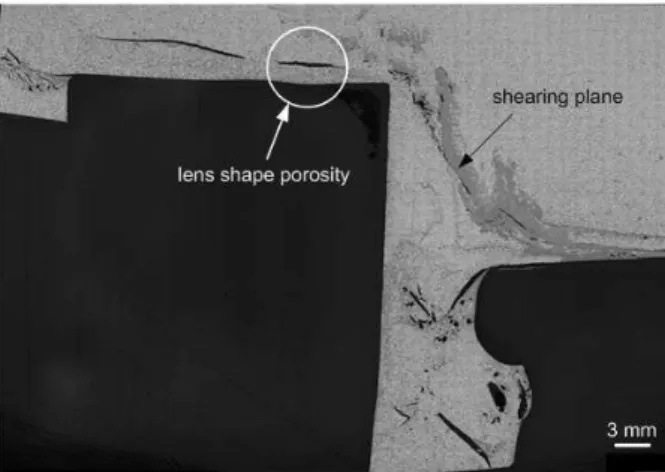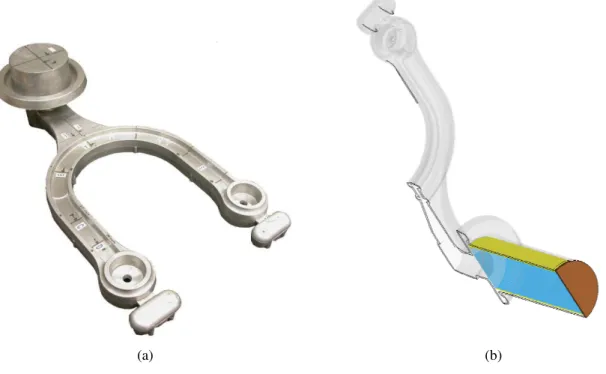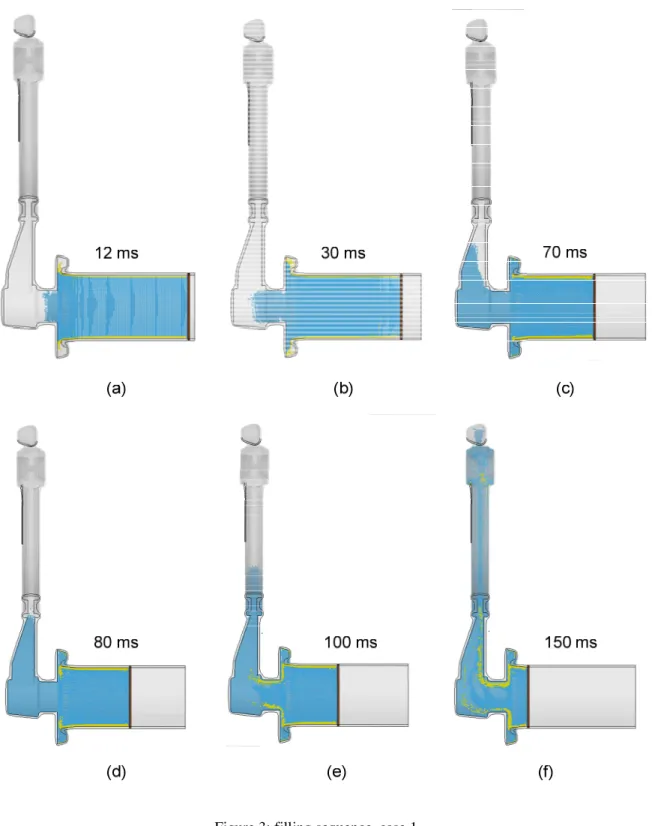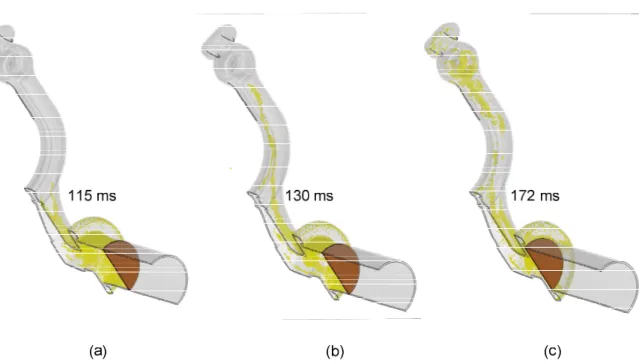Publisher’s version / Version de l'éditeur:
European LS-DYNA Conference, 2011-05-22
READ THESE TERMS AND CONDITIONS CAREFULLY BEFORE USING THIS WEBSITE. https://nrc-publications.canada.ca/eng/copyright
Vous avez des questions? Nous pouvons vous aider. Pour communiquer directement avec un auteur, consultez la première page de la revue dans laquelle son article a été publié afin de trouver ses coordonnées. Si vous n’arrivez pas à les repérer, communiquez avec nous à PublicationsArchive-ArchivesPublications@nrc-cnrc.gc.ca.
Questions? Contact the NRC Publications Archive team at
PublicationsArchive-ArchivesPublications@nrc-cnrc.gc.ca. If you wish to email the authors directly, please see the first page of the publication for their contact information.
NRC Publications Archive
Archives des publications du CNRC
This publication could be one of several versions: author’s original, accepted manuscript or the publisher’s version. / La version de cette publication peut être l’une des suivantes : la version prépublication de l’auteur, la version acceptée du manuscrit ou la version de l’éditeur.
Access and use of this website and the material on it are subject to the Terms and Conditions set forth at
Application of LS-DYNA SPH Formulation to Model Semi-Solid Metal
Casting
Pineau, F.; D’Amours, G.
https://publications-cnrc.canada.ca/fra/droits
L’accès à ce site Web et l’utilisation de son contenu sont assujettis aux conditions présentées dans le site
LISEZ CES CONDITIONS ATTENTIVEMENT AVANT D’UTILISER CE SITE WEB.
NRC Publications Record / Notice d'Archives des publications de CNRC: https://nrc-publications.canada.ca/eng/view/object/?id=4f90ba83-e6e0-4adc-a578-474d8d33bd0d https://publications-cnrc.canada.ca/fra/voir/objet/?id=4f90ba83-e6e0-4adc-a578-474d8d33bd0d
Application of LS-DYNA SPH Formulation to Model
Semi-Solid Metal Casting
F. Pineau, G. D’Amours
National Research Council Canada, Aluminium Technology Centre, Quebec, Canada
Abstract
Semisolid metal alloys have a special microstructure of globular grains suspended in a liquid metal matrix. This particular physical state of the matter can be exploited to produce near-net-shape parts with improved mechanical properties. Indeed, semi-solid processes take advantage of a much higher apparent viscosity of the die cast materials by limiting the risk of oxide formed on the free surfaces to become incorporated into the casting when the material is injected into the die.
Semi-solid processes that use billets as feedstock material are however tied up with an additional type of surface contamination. During the injection phase, the external-skin on the periphery of the billet, which has been in contact with air and lubricant during the transfer in the shot sleeve may be incorporated into the casting. This can be an important cause of reject for most structural parts in the automotive industry.
In order to predict and control the occurrence of skin inclusion into cast parts during the injection phase of semi-solid processes, Lagrangian methods are appropriate. Indeed, the skin, composed of contaminated or even partially solidified metal, has different mechanical properties compared to the core of semi-solid aluminum. Abitrary-Lagrangian-Eulerian formulations, which can account for the coupling between the “solid” skin and the flow of “semi-solid” aluminum are promising but still necessitate a huge amount of computer power. On the other hand, particle based Smoothed Particle Hydrodynamics (SPH) approaches are particularly well suited to this kind of flows involving complex flow behavior and solidification. These methods are able to track accurately free surface flows with fragmentation and break up as well as to follow the advection of oxides through the flow.
In this paper, a first analysis is performed in order to investigate the potential of the SPH solver of LS-DYNA to deal with the problem of skin inclusion in semi-solid die casting processes. Preliminary results show that the SPH approach is a very promising simulation tool to follow the skins during semi-solid injection casting.
Introduction
Semi-solid metal processing is an attractive technology to produce near net shape engineering components by pressure die casting e.g. [1]. In these processes, aluminum alloys are injected into a mould at a temperature lying between the liquidus and solidus. At this temperature, the material looks like a semi-solid slurry having a rather high local apparent viscosity. At rest, the material stands on its own. When sheared, the bonds between the particles are broken and the material flows easily (shear thinning behaviour). The material thickens again when it is allowed to stand for a while. Furthermore, the semi-solid metal slurry behaviour is dependent on the temperature, (which also governs the solid fraction), as well as on the shape of the particles in the suspension. These features can be exploited to fill mould cavities in a progressive manner, thus cutting down on splashing as well as on gas, oxides and skin entrapment. This permits to produce parts with low porosity and uniform microstructure, which can then be heat treated to improve their mechanical properties. Semi-solid processes are thus suitable for the production of structural applications in the automotive industry.
Semi-solid slurries are first obtained by stirring the alloys during the solidification step in order to produce a non-dendritic solid phase within the liquid metal matrix. Ideally, the semi-solid material should be homogeneous but in practice, it is not completely right. For instance, in many rheo-moulding processes e.g. [2], the billet is obtained from liquid aluminum that partially solidifies before being injected into the cavity as a semi-solid material. During the preparation of the billet and its transfer into the shot sleeve, the aluminum in contact with the container wall may form a “skin” around the semi-solid core. The top circular surface of the billet that remains in contact with air during the billet preparation is also prone to oxidation.
When inserted horizontally into the shot sleeve, the contact between the bottom part of the billet and the shot sleeve wall is greater because of gravity. The heat transfer is also greater there and yields a “skin” that may be partially solidified. The “thickness” of the skin depends on the time spent in the shot sleeve before the injection. Most of the lubricant in the shot sleeve lies at the bottom and gets in contact with the external surfaces. When injected into the cavity, these contaminated surfaces will probably enter into the part and yield undesired defects.
During heat treatment of the part, the lubricant that contaminated the surfaces that were injected into the casting, is decomposed and produces “lens shape” porosities as depicted in figure 1.
Figure 1: Porosity lens defects along a shearing plane
On this figure, the defects are on the shearing plane, where they were formed, but they could also propagate downstream depending on the ensuing velocity field. These defects can have definitely detrimental effects on the part integrity. To limit any serious consequences, the distribution of the skin inside the casting must be managed by properly controlling and directing the flow during the injection phase. In order to achieve that, a proper technique to predict the possible paths followed by the skin inclusions must first be developed. In this paper, prediction of skin inclusion in semi-solid casting processes by using the smooth particle hydrodynamics (SPH) approach of LS-DYNA is thus investigated.
Modelling
Modelling semi-solid processes is challenging as it sits on the edge between solid deformation and fluid mechanics modelling [3]. The semi-solid material is considered as a saturated two phase medium made of liquid and solid phases. Each phase has its own behaviour, which can be affected by the presence of the other phase by means of interfacial contributions. As described in the previous section, the semi-solid billet frequently includes a “partially-solidified” skin which is often contaminated by oxides and lubricants. All these features must be considered in order to properly model the injection of semi-solid billet into the die.
Many models have been developed to account for the two-phase nature of the flow, e.g. [4]. These models permit to describe the segregation phenomena between the phases and to define
more accurate rheological behaviours for the semi-solid slurry. In the end, the mechanical properties should be predicted with more details but these models are rather complex and involve to identify several parameters that are difficult to obtain. Some models consider the slurry as a one phase bulk material with an effective viscosity described by a “power law” that considers the shear rate and temperature dependencies, e.g. [5]. These Eulerian approaches are very useful to predict the flow fronts during the mould filling phase. However, they are less appropriate when one wants to follow the evolution of the skin material. Indeed, the skin is partially solid and has different mechanical properties. Moreover, it is very thin. Ideally, one should treat the problem as a fluid structure interaction problem with the skin being a “solid foil” carried by the semi-solid slurry that can be folded and broken. This kind of modelling can be achieved by an Arbitrary Lagrangian-Eulerian approach as described in ref [6]. But calculation times are way too long. Moreover, proper material properties for the “skin” are difficult to evaluate.
Smooth Particle Hydrodynamics (SPH) is a meshfree, Lagrangian particle method for modelling fluid flows. The scheme was initially developed by Lucy [7], and Gingold and Monaghan [8] to solve astrophysical problems in three-dimensional open space. Besides the meshfree and adaptative nature of the method, the particles in SPH also carry material properties. The latter can move in relation to the internal interactions between the particles as well as to the external forces applied to the “fluid” domain. The method has already been successfully applied to predict the oxides generated by several casting pouring processes e.g. [9-11]. To the author`s knowledge, there is only one reference in the literature that has applied the SPH method to the investigation of semi-solid two-phase flows [12].
In this paper, the Smooth Particle Hydrodynamics method is used to model the injection of a semi-solid billet into a mould. The method is applied to give a preliminary approximation for the skin inclusion problem occurring in semi-solid casting processes.
Problem settings
The problem considered in this paper is the casting of a suspension arm by semi-solid metal process. The “as cast” part is depicted in figure 1-(a). The ring around the shot sleeve end is designed to catch the skin and oxides on the billet surface [13]. The equivalent SPH model includes the shot sleeve, the billet, the plunger and the mould contours as depicted in figure1-(b).
At time t=0, only the shot s skin of the billet is identified properties of the core of
(a) Figu
For this problem, length and ti velocity is set constant to 1 m 172 mm. “CONTACT AUTOM the die walls. Die and plunger approximated by “MAT NULL
Number o D Dynam
As a first approximation, the v is actually shear rate and tem
ot sleeve is filled. The remaining volume of the ied on the sides by yellow particles. In this s
-solid aluminum. The case is considered as iso
(b) igure 2: Suspension arm and associated SPH model
d time units are respectively millimeter and mil mm/ms. Filling thus takes place in 172 ms and OMATIC NODE TO SURFACE” is used betw er parts are considered as “RIGID” materials. T LL” material. The model parameters are presen
Table 1 – SPH model parameters
r of SPH particles N = 123341
Density 2.67x10-3 g/mm-3
amic viscosity 1.0x10-3 MPa.ms
e viscosity of the material is taken as constant temperature dependent). The initial number of
the mould is empty. The study, the skin has the isothermal.
millisecond. The plunger and the plunger stroke is etween the particles and The semi-solid billet is ented in table 1.
nt, (physically, the latter of neighbours is set to
2000. In the SPH SECTION definition of the problem, the constant applied to the smoothing length of the particles is set to 1.2. To reduce the size of the problem and to model only one half of the suspension arm, a “BOUNDARY SPH SYMMETRY PLANE is employed on the symmetry plane.
Results and discussions
It must be emphasized that the aim of this work is essentially to show the potential of the SPH approach to eventually follow and control skin inclusions into semi-solid cast parts.
Figure 3 shows the filling sequence at the shot sleeve level. The results are shown on the symmetry plane. The plunger moves leftward and pushes the semi-solid metal against the diaphragm. The later device acts as a constriction which promotes the incorporation of the core of the billet into the feeding channel. An oxide ring is also set at the same plane, on the perimeter of the sleeve, to trap the oxidized skin and lubricants that are on the peripheral billet surface. At t = 12 ms the “skin”, in yellow, begins to enter into the oxide ring, see figure 3-(a). The oxide remover device works well as long as the reservoir is not completely filled up, figures 3-(b) and (c). At t=80 ms, the skin is forced inward and is directed into the channel and carried over inside the casting. According to this simulation, the skin material inside the part is depicted in figure 4 for three different times. Note that the “biscuit”, the portion of metal that remains in the shot sleeve, is very thin. Consequently, almost all the material has been pushed into the mould. Also, as most of skin inclusion occurs at the end of the plunger stroke, a thicker biscuit would undoubtedly produce better results, i.e. less skin inclusion inside the part.
Another possibility is to avoid the “scraping” action of the piston on the rear section of the billet by using a two-piece injection plunger tip in a manner that is very similar to the ACCURAD principle [14]. For this semi-solid application, the centre section moves together with the outer section at the beginning of the stroke, in order to fill the injection chamber. Then, the outer plunger is stopped and only the inner plunger continues moving to fill the part. This method of injection avoids the scraping of the skin material. At the end, the outer section ejects the “skin” when the mould is open. The proposed arrangement is depicted in figure 5. With this configuration, skin particles from the front portion of the billet are again caught by the oxide ring while skin particles from the back portion of the billet remain on the wall. The final skin particle distribution at the end of filling is shown in figure 6. It can be seen that skin inclusion is lesser than the previous case shown in figure 4.
Figure 4: potential “skin defect” locations as predicted by the SPH model, case 1
Figure 6: potential “skin defect” locations as predicted by the SPH model, case 2
Conclusions
The present study should be regarded as a preliminary investigation of the application of SPH modelling to flow of semi-solid metal. In this study, several simplifications have been made in the model regarding the nature of the quite complex thixotropic flow with solidification. Nevertheless, the isothermal approach presented seems very promising. It is shown that skin inclusions can be avoided by properly designing the injection sleeve and plunger assembly. Indeed, the skin has to be stripped from the billet walls before it goes through the injection channel entry. Behind that point, no control is possible as it is easily mixed with the aluminum core. Of course, a non-Newtonian temperature dependant constitutive model should be used in the future to better approximate the complex nature of semi-solid flows. Particles representing the skin should also have their own material properties. Then, these new simulation results should be compared and validated with real cast parts.
References
1 Kirkwood D.H., Suéry M., Kapranos P., Atkinson H.V. and Young K.P., Semi-solid Processing of Alloys, Springer Series in Materials Science 124, 172 p, (2010).
2. Doutre D, Hay G, Wales P, Gabathuler J. P. SEED: A new process for semi solid forming. Canadian Metallurgical Quarterly, 43(2): 265−272, (2004)
3. Favier V., Solid Approach- Fluid Approach: What differences?, Modelling of Semi-Solid Processing, Chapter 5, H.V. Atkinson ed. Shaker Verlag, Aachen, 105-122, (2008)
4. Atkinson H.V., Modelling the semisolid processing of metallic alloys, Progress in Materials Science 50, 341-412, (2005)
5. Orgeas L, Gabathuler J-P, Imwinkerlried Th, Paradies Ch, Rappaz M: Modelling of semi-solid processing using a
modified temperature-dependent power-law model. Modelling Simul. Mater. Sci. Eng. 11: 553-574, (2003).
6. Pineau, F and D’Amours G., Prediction of shear-related defect location in semi-solid casting using numerical
flow models. Trans. Nonferrous Met. Soc. China 20: s878-s882, (2010).
7. Lucy L.B., Numerical approach to testing the fission hypothesis, Astronomical Journal, 82: 1013-1024, (1977).
8. Gingold R.A and Monaghan J.J., Smoothed Particle Hydrodynamics: Theory and Application to Non-spherical
stars, Monthly Notices of the Royal Astronomical Society, 181: 375-389, (1977).
9. Cleary P., Prakash M., Sinnott M., Grandfield J., Alguine V. and Oswald K. 3D SPH simulations of the aluminium
ingot casting process, Proceedings of the Third International Conference on CFD in the Minerals and Process
Industries. CSIRO, Melbourne, Australia, 409-414, December (2003)
10. Prakash M., Pereira G.G., Cleary P.W., Rohan P. and Taylor J.A., Validation of SPH predictions of oxides
generated during Al melt transfer. Proceedings of the seventh International Conference on CFD in the Minerals and
Process Industries. CSIRO, Melbourne, Australia, 1-6, December (2009).
11. Prakash M., Cleary P. and Grandfield J., Modelling of metal flow and oxidation during furnace emptying using
smoothed particle hydrodynamics. Journal of Materials Processing Technology 209, 3396-3407, (2009)
12. Yamashita Y., Okada H., Sakai Y. and Fukui Y., On the flow Analysis of Semi-Solid Forming of Functionally
Graded Material by using Smoothed Particle Hydrodynamics Method. Nihon Kikai Gakkai Nenji Taikai Koen
Ronbunshu 1, 33-34, (2006).
13. Erich Röllin; Hansjörg Huber; Jean-Pierre Gabathuler. Oxide Remover. U.S. Patent 5,730,201, Mar. 24, (1998).
14. Harrison P.F., Development of the Cold Chamber Pressure Die Casting Machine, Journal of the Institution of Production Engineers, Vol. 51, (9), 289-297, September (1972).




